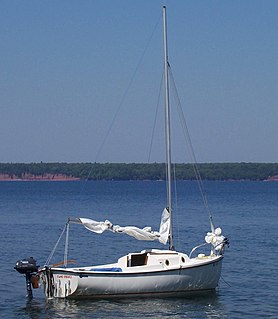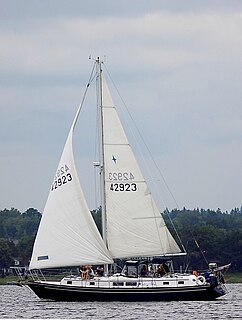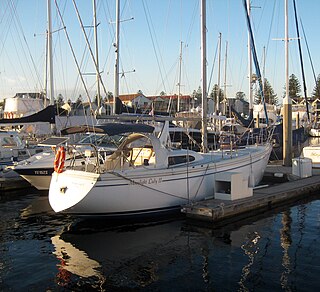The Pearson Triton, sometimes referred to as a Triton 28, is an American sailboat that was designed by Carl Alberg as a racer-cruiser and first built in 1958. It was introduced at the 1959 National Boat Show in New York City and was one of the first fiberglass boat designs built. The design also launched Alberg's career as a naval architect.
The Newport 16 is an American trailerable sailboat that was designed by Bill Lapworth as a daysailer and a pocket cruiser and first built in 1965.

The Catalina 22 is an American trailerable sailboat that was designed by Frank V. Butler and first built in 1969.

The Com-Pac 16 is an American trailerable sailboat that was designed by Clark Mills as a small cruiser and first built in 1972.

The Gulfstar 43 is an American sailboat that was designed by Vince and Richard Lazarra as a cruiser and first built in 1971.
The Columbia 36 is an American sailboat that was designed by William Crealock and first built in 1967.
The Columbia 24 Challenger, or Columbia Challenger 24, is an American trailerable sailboat that was designed by Joseph McGlasson and first built in 1962.
The Columbia 24 Contender is an American trailerable sailboat that was designed by Joseph McGlasson in conjunction with Columbia Yachts and first built in 1963.
The Islander 24 is an American sailboat that was designed by Joseph McGlasson and first built in 1961.
The Islander 24 Bahama, also called the Islander Bahama 24, is an American trailerable sailboat that was designed by Joseph McGlasson and first built in 1964.
The Com-Pac 25 is an American trailerable sailboat that was designed as a cruiser.

The Columbia 34 Mark II is an American sailboat that was designed by William H. Tripp Jr. as a coastal cruising sailboat and first built in 1970.
The Columbia 38 is an American sailboat that was designed by Charles Morgan as racer-cruiser and first built in 1965.
The S2 11.0 is a series of American sailboats that was designed by Arthur Edmunds as cruisers and first built in 1977. The designation indicates the approximate length overall in meters.
The Cal 39 Mark II and Cal 39 Mark III are a series of American sailboats that were designed by C. William Lapworth as racer-cruisers to fit the International Offshore Rule and first built in 1978.
The Nordic 44 is an American sailboat that was designed by Robert Perry as a racer-cruiser and first built in 1980.
The Buccaneer 240 and Buccaneer 245 are a family of American trailerable sailboats that were both designed as cruisers and first built in 1975.
The Islander 21 is an American trailerable sailboat that was designed by Joseph McGlasson as a pocket cruiser and first built in 1965.
The S2 9.1 is an American sailboat that was designed by Graham & Schlageter as a Midget Ocean Racing Club (MORC) racer and first built in 1983. The boat was built in a variety of models. The designation indicates the approximate length overall in meters.
The Windrose 22 and Laguna 22 are a series of American trailerable sailboats that were designed by W. Shad Turner as cruisers and first built in 1977.




